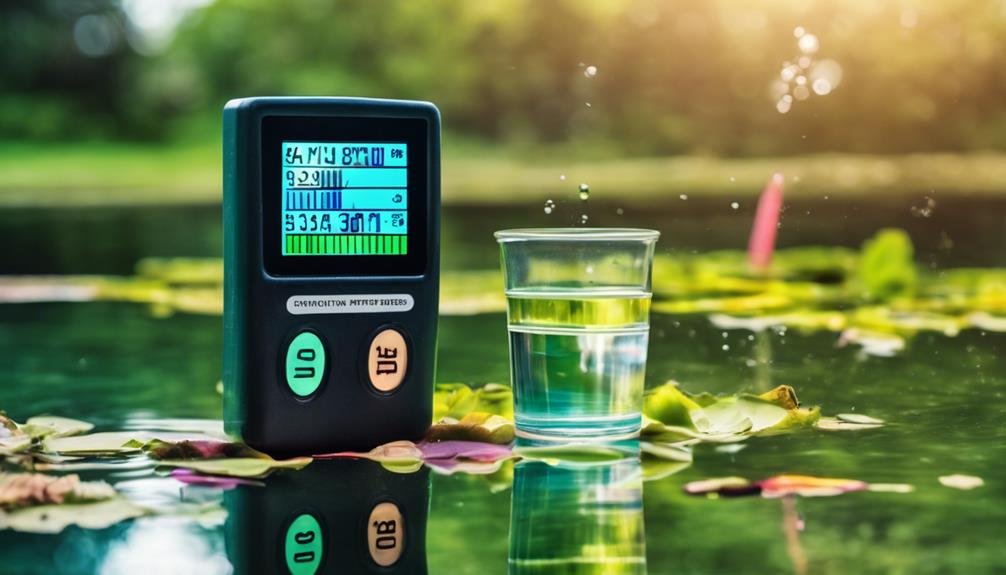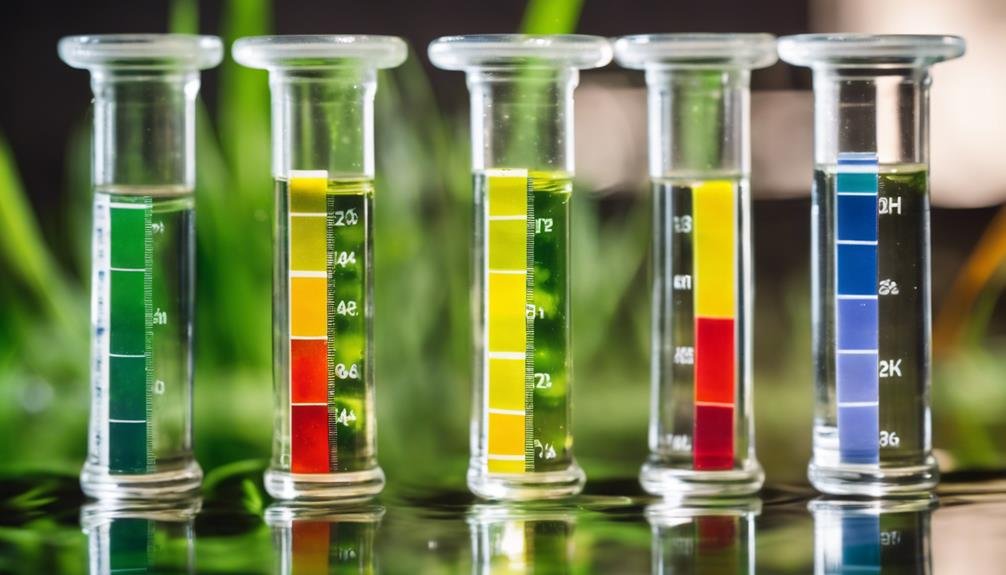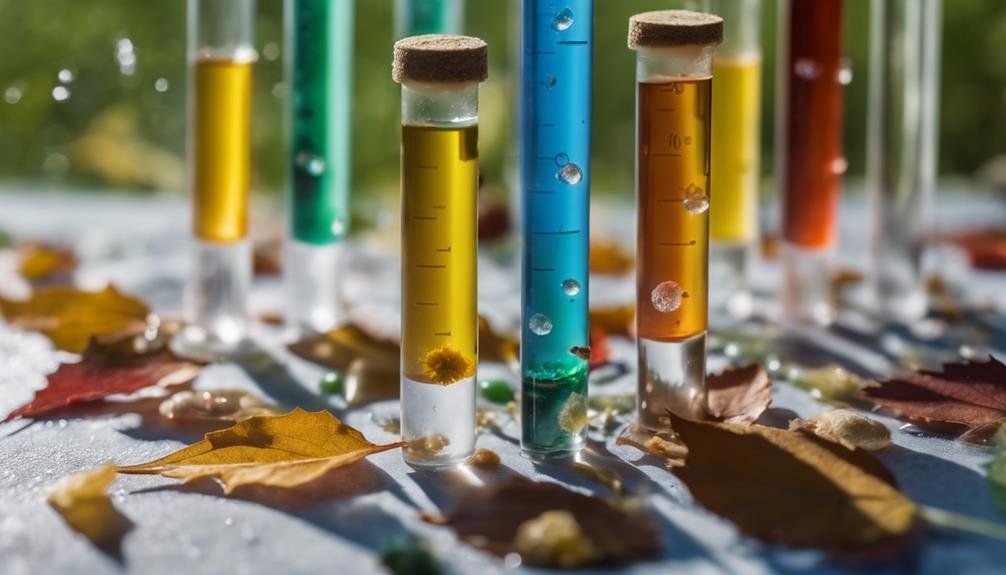For top-rated pond water testing kits, consider API Test kits and digital options like the Seneye Pond Pack. These provide accurate, quick results for essential parameters including pH, ammonia, nitrite, and nitrate levels. API kits are known for their reliability, while digital options offer real-time monitoring and alerts. Budget-friendly alternatives start at $13.95, offering basic testing capabilities. Both strip and digital tests have their merits, depending on your needs and budget. Regular testing is vital for maintaining a healthy pond ecosystem, helping you detect and address issues early. Understanding the pros and cons of each kit type will guide you to the best choice for your pond.
Some of the links in this article may be affiliate links. If you make a purchase through these links, we may earn a small commission at no extra cost to you. Thank you.
Importance of Pond Water Testing
As a pond owner, you'll find that regular water testing is essential for maintaining a thriving aquatic ecosystem. Water gardens require consistent monitoring to guarantee the health of fish and plant life. By testing your pond water frequently, you'll be able to identify and address potential issues before they become serious problems.
One of the key aspects of pond water testing is monitoring pH levels and ammonia content. These factors play an important role in preventing algae blooms, which can disrupt the balance of your pond's ecosystem. Additionally, identifying nitrite and nitrate levels helps guide proper water balance management, ensuring ideal conditions for aquatic life.
Testing kits designed specifically for pond water offer quick and accurate results, allowing you to take proactive measures in maintaining your water garden. These kits typically measure various parameters, including pH, ammonia, nitrites, and nitrates. By regularly using these tests, you'll be able to make informed decisions about water treatments, filtration adjustments, or other necessary maintenance tasks.
Ultimately, consistent water testing is the foundation of a well-balanced pond ecosystem. It helps you maintain clean, healthy water that supports thriving fish populations and vibrant plant life in your water garden.
Types of Water Tests
When it comes to pond water testing, you'll need to familiarize yourself with several key types of tests that are essential for maintaining a healthy aquatic environment.
The most common pond tests include pH, ammonia, nitrite, nitrate, and temperature measurements. These tests are important for ensuring that your pond's water is free from toxins and suitable for fish like Koi.
pH testing helps you monitor the acidity or alkalinity of your pond water. Ammonia, nitrite, and nitrate tests are essential for evaluating the nitrogen cycle in your pond, which can impact fish health. Temperature measurements are significant for understanding seasonal changes and their effects on aquatic life.
Best Overall Testing Kits

To safeguard your pond's health, you'll want to invest in one of the best overall testing kits available on the market. API Test kits are highly recommended for their accuracy and speed in delivering results. These kits provide you with reliable data about your pond's water quality, allowing you to make informed decisions about its maintenance.
If you're looking for convenience and real-time monitoring, digital water testing kits are an excellent choice. These kits offer quick access to water quality information, enabling you to stay on top of any changes in your pond's ecosystem. One standout option is the Seneye Pond Pack, which can send alerts when significant water quality changes occur. This feature is particularly important as it allows you to take prompt action if needed.
Some digital kits even offer email or phone notifications, ensuring you're always informed about drastic changes in your pond's water quality. This immediate communication can be vital in preventing potential issues from escalating.
If you need more information or want to place a phone order for the best overall pond water testing kits, you can contact 206-966-4842 for assistance.
Budget-Friendly Options
You don't have to break the bank to keep tabs on your pond's water quality. Budget-friendly pond water testing kits are available starting at just $13.95, offering cost-effective solutions for regular monitoring. These affordable options guarantee you can efficiently maintain your pond's health without straining your wallet.
When considering budget-friendly pond water testing options, keep these key points in mind:
- Low-cost kits provide essential testing capabilities
- Regular testing is possible without significant expense
- Bulk purchase discounts offer additional savings
- Value for money in monitoring water quality
These economical kits allow you to perform frequent tests, helping you stay on top of your pond's water conditions. By opting for budget-friendly options, you're not sacrificing the ability to maintain a healthy aquatic environment. Instead, you're making a smart choice that balances cost with effectiveness.
Digital Vs. Strip Test Kits

In the field of pond water testing, you'll find two main contenders: digital test kits and strip test kits. Both options offer unique advantages for monitoring your pond's water quality.
Digital test kits provide real-time monitoring of essential parameters like pH, ammonia, and nitrate levels. These advanced tools often come with alerts for significant changes in water quality, ensuring you can take timely action to maintain a healthy pond ecosystem. The digital format allows for precise measurements and easy tracking of water conditions over time.
Strip test kits, on the other hand, offer quick and convenient on-the-spot results. They're cost-effective options for regular monitoring of basic water quality parameters. While they may not provide the same level of detail as digital kits, strip tests are user-friendly and require minimal training to use effectively.
Both types of test kits are essential tools for pond maintenance. Your choice between digital and strip test kits will depend on your specific needs, budget, and the level of detail you require in your water quality assessments.
Whichever option you choose, regular testing will help you maintain a thriving pond environment.
Frequency of Water Testing
Consistency is the key when it comes to testing your pond water. Weekly checks form the backbone of a robust maintenance routine. Regular testing helps you stay on top of water quality, preventing imbalances and keeping your pond ecosystem healthy.
It's particularly important to conduct tests after significant events or changes in your pond environment. Here are four important times to test your pond water:
- Weekly, as part of your regular maintenance schedule
- After heavy rainfall or other significant weather events
- Before introducing new fish or plants to the pond
- During seasonal changes, to help adjust your care routines
Interpreting Test Results

Once you've conducted your water tests, it's time to make sense of the numbers you've gathered. Interpreting test results is essential for maintaining ideal water quality in your pond.
Your test strips will provide important information on key parameters such as pH levels, ammonia content, nitrites, nitrates, and temperature. Understanding these results allows you to make informed decisions about your pond's health.
pH levels indicate water acidity or alkalinity, while ammonia, nitrite, and nitrate levels reveal the effectiveness of your filtration system. Temperature readings help you adjust care routines seasonally.
By regularly monitoring these parameters, you can prevent potential issues before they become significant problems. High ammonia or nitrite levels, for instance, can be toxic to fish and require immediate action.
Elevated nitrate levels might indicate the need for more frequent water changes or additional plants to absorb excess nutrients. Test results also help you identify the presence of harmful bacteria, fungi, or toxins.
This knowledge enables you to take proactive measures, ensuring pristine water conditions and preventing algae blooms. Proper interpretation of your test results is crucial for maintaining a healthy, balanced pond ecosystem throughout the year.
Addressing Common Water Issues
Armed with your test results, you're now ready to tackle common water issues that plague many pond owners. Understanding these problems allows you to take proactive measures, maintaining a balanced ecosystem in your pond. Here are four common issues you might encounter and how to address them:
- pH imbalance: Adjust pH levels using appropriate treatments to maintain ideal conditions for fish and plants.
- Ammonia spikes: Reduce fish feeding, remove debris, and consider adding beneficial bacteria to help break down waste.
- High nitrate levels: Perform partial water changes and add aquatic plants to absorb excess nutrients.
- Algae overgrowth: Limit sunlight exposure, remove excess nutrients, and introduce algae-eating fish or beneficial bacteria.
Regular testing is important for detecting these issues early, allowing for timely intervention. By monitoring your pond's water quality, you can prevent fish stress, maintain clarity, and adjust your management practices accordingly.
This includes modifying water treatments, feeding schedules, and overall pond maintenance. Remember, a well-balanced pond ecosystem relies on your ability to quickly identify and address these common water problems.
With consistent testing and appropriate actions, you'll be well-equipped to maintain a healthy, thriving pond environment.
Seasonal Testing Considerations

Throughout the year, you'll need to adjust your pond testing routine to account for seasonal changes that can greatly impact water quality. As different seasons arrive, you may notice fluctuations in pH levels, ammonia concentrations, and nitrate content in your pond water. To maintain a balanced ecosystem, it's important to conduct regular tests during each season.
Using test kits consistently throughout the year allows you to monitor these changes effectively. By doing so, you'll be able to identify potential issues before they become serious problems. This proactive approach enables you to adjust your pond care and treatments based on the specific needs of each season.
For instance, you might find that your pond's pH levels tend to rise during summer months due to increased algae growth. Armed with this knowledge, you can take appropriate measures to maintain ideal water conditions.
Similarly, higher ammonia levels in spring might prompt you to adjust your filtration system or feeding habits.
Professional Vs. DIY Testing
When it comes to testing your pond water, you've got two main options: professional analysis or do-it-yourself kits. Professional testing involves certified experts conducting thorough water analysis, offering detailed insights into various quality parameters. While this option may be more expensive, it provides detailed analysis and personalized recommendations.
On the other hand, DIY testing kits offer convenience and cost-effectiveness for regular monitoring. These user-friendly kits provide quick results that are easy to interpret, making them ideal for routine checks.
Consider the following factors when choosing between professional and DIY testing:
- Frequency of testing required
- Budget constraints
- Level of detail needed in results
- Your comfort level with interpreting test results
Professional testing is recommended for initial assessments or when you suspect complex water quality issues. DIY kits are suitable for ongoing monitoring and basic parameter checks.
You may find that a combination of both methods works best, using professional services periodically while relying on DIY kits for regular testing.
Ultimately, the choice between professional and DIY testing depends on your specific needs, budget, and the complexity of your pond's ecosystem. Both options have their merits, and selecting the right approach will help safeguard the health of your pond.
Frequently Asked Questions
How Do I Test the Quality of My Pond Water?
You can test your pond water quality using API Test kits for quick assessments of pH, ammonia, nitrites, nitrates, and temperature. For real-time monitoring, consider digital kits like Seneye Pond Pack. Regular testing helps maintain ideal conditions for your fish.
Are DIY Water Testing Kits Accurate?
Like a scientist in your own lab, you'll find DIY water testing kits can be quite accurate. They're designed for reliable home use. Just follow instructions carefully, calibrate regularly, and handle properly. If you're unsure, consult experts for guidance.
How Often Should You Test Your Pond Water?
You should test your pond water weekly for best monitoring. Increase testing frequency during temperature changes or heavy rain. It's wise to test after adding new fish or plants, and before and after pond treatments. Regular testing prevents issues.
What Is the Best Testing for Well Water?
For thorough well water testing, you'll want a complete kit that checks pH, hardness, ammonia, nitrates, nitrites, and common contaminants like bacteria and lead. Test regularly and consider consulting experts for the most accurate assessment of your water quality.
Conclusion
You're now equipped to maintain your pond's health like a seasoned aquarist.
Regular testing is essential, just as a doctor monitors vital signs. Whether you choose digital or strip kits, budget-friendly or professional options, the key is consistency.
Remember to adjust your testing frequency with the seasons and don't hesitate to seek professional help for complex issues.
With these tools and knowledge, you'll keep your aquatic ecosystem thriving year-round.

